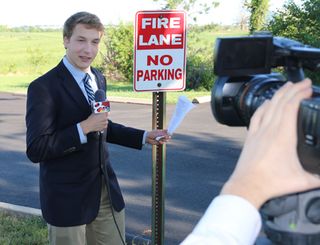Class Acts Help Students Succeed in TV

Thanks to technology, the times they are a-changin’ in the TV industry, and fast. The process of training budding broadcasters, by necessity, now involves a new, much more elaborate process.
“When we say preparing for television now, that means preparing for television, online and mobile, because there are no just-TV jobs anymore,” says Mary Rogus, associate professor at Ohio University’s E.W. Scripps School of Journalism. Thankfully, many colleges and universities have top programs doing just that.
The days when someone could walk into a TV station without a college broadcast journalism background and expect to land a job are fading, according to B. William Silcock, associate professor at Arizona State University’s Walter Cronkite School of Journalism and Mass Communication. News directors, particularly in smaller markets, don’t have time for on-thejob training due to staff and budget cuts.
“When I started in the business, I had a photographer and an editor; now it’s all one-manband,” says Silcock, a former TV news anchor, producer and news director. “There’s so much more demanded today…you need to attend a [broadcast] journalism school.”
Hearst Television VP of news Barbara Maushard says the best job candidates have experience producing content for multiple platforms. “That can come from a strong on-campus broadcast experience or an internship,” she says. “We also commit to training recent graduates who show ability and desire to grow. So while a degree from a wellrespected journalism program will get a candidate noticed and start them on a good path, I find it always boils down to the person’s ability and fit for the opening.”
Silcock says there are measures that can be used in deciding what may be the best college TV programs to try to get into. These include how many of the schools’ graduates are getting jobs in the industry, and which programs fare well in the Hearst Journalism Awards Program, which Silcock calls the “Oscars of college television.”
Students from five highly regarded college TV schools were the top winners in this year’s Hearst National Television Broadcast News Championship: Arizona State, Brigham Young, Northwestern, University of North Carolina and Missouri. Top schools overall in the Hearst TV competition were Missouri, Nebraska, Arizona State, UNC, Northwestern, BYU, Penn State, University of Southern California, Washington and Lee, Florida and Elon University.
Broadcasting & Cable Newsletter
The smarter way to stay on top of broadcasting and cable industry. Sign up below
Broadcast Education Association executive director Heather Birks says TV schools that tend to filter to the top in the BEA’s annual creative competition, the Festival of Media Arts, are Arizona State, Penn State, UNC, BYU, Elon and the University of Oklahoma.
The TV industry can count on a constant flow of fresh on-air and production talent from a host of other highly regarded schools, including Syracuse, Columbia, Illinois, Boston College, Boston University, Emerson, Ithaca, Ohio University, Georgia, Hofstra, Washington State, Indiana, Texas and West Virginia, among others. A discussion of top TV production programs also includes USC, New York University, UCLA, Loyola Marymount, Brooklyn College, Temple and DePaul.
Increasingly, newer players are working their way into the picture. “I’m always impressed by the TV production, sports in particular, coming out of schools like St. Cloud State and Ball State,” Birks says. “These other players have absolutely joined the big boys. I think it’s been the result of schools that adopted new media and communication tools while teaching the value and skill of research and telling stories.”
Silcock says the best college TV programs talk about theory in the classroom and practice it in a laboratory setting. His school, Arizona State, provides real-world training in a variety of ways, including a live newscast on PBS, news bureaus in Phoenix and Washington, D.C., and a sports broadcasting bureau in Los Angeles.
“A wonderful metaphor to think about is the teaching hospital model,” Silcock says. “We’re serving the community, just like a hospital does. We embed ourselves in the community, provide a service, and as long as the people behind the scenes are double-checking what the students are doing, I think they can be just as compelling storytellers as somebody who’s been working in the business for five years.”
The teaching hospital model holds true, too, at Ohio University in Athens, Ohio, where students are encouraged to innovate and enterprise in the classroom and on the university-licensed public TV and radio stations.
“Instead of just saying, ‘OK, here’s an assignment, do a story on this,’ we say, ‘What do you want to produce?’” Rogus of Ohio University says. “And then they’re going to have to produce it for TV or radio, put something on the Web, do social media and bring it all together so when they walk out of here, they’ve got a portfolio that really talks. And that’s what’s getting them jobs.”
Ball State has benefitted from the support of its most famous alum, David Letterman, who has shown his alma mater a lot of love on the air throughout his 32-year late-night TV career. He also has donated money for scholarships, a lecture series and the creation of the campus radio station. The Muncie, Ind., university named the communications complex, including world-class production facilities, for Letterman in 2007. But the university really made the grade in 2007 courtesy of a Top 10 List of “Good Things About Having Your Name on a Building” that Letterman entertained the crowd with at the dedication ceremony.
(Photo: KOMU’s Zack Newman, a Missouri sophomore, covering a story for the university-owned NBC affiliate.)
